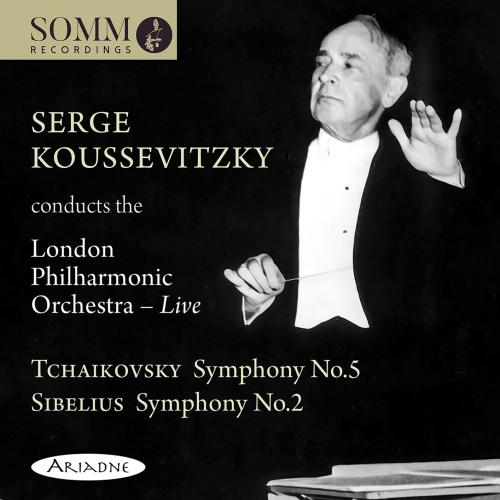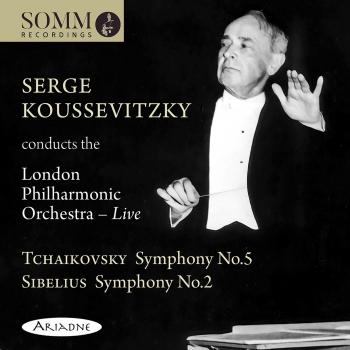
Serge Koussevitzky Conducts the London Philharmonic Orchestra (Live) London Philharmonic Orchestra & Serge Koussevitzky
Album Info
Album Veröffentlichung:
2022
HRA-Veröffentlichung:
19.08.2022
Label: SOMM Recordings
Genre: Classical
Subgenre: Orchestral
Interpret: London Philharmonic Orchestra & Serge Koussevitzky
Komponist: Jean Sibelius (1865-1957), Peter Iljitsch Tschaikowsky (1840-1893)
Das Album enthält Albumcover
- Pyotr Ilyich Tchaikovsky (1840 - 1893): Symphony No. 5 in E Minor, Op. 64, TH 29:
- 1 Tchaikovsky: Symphony No. 5 in E Minor, Op. 64, TH 29: I. Andante - Allegro con anima (Live) 15:37
- 2 Tchaikovsky: Symphony No. 5 in E Minor, Op. 64, TH 29: II. Andante cantabile con alcuna licenza (Live) 14:30
- 3 Tchaikovsky: Symphony No. 5 in E Minor, Op. 64, TH 29: III. Valse. Allegro moderato (Live) 06:22
- 4 Tchaikovsky: Symphony No. 5 in E Minor, Op. 64, TH 29: IV. Finale. Andante maestoso - Allegro vivace (Live) 11:36
- Serge Koussevitzky, A Memoir, Pt. 1:
- 5 Tchaikovsky, Strauss, Liszt, Berlioz: Serge Koussevitzky, A Memoir, Pt. 1: La damnation de Faust, H 111 - Symphony No. 5 in E Minor, Op. 64, TH 29 - Till Eulenspiegels lustige Streiche, Op. 28, TrV 171 - Romeo and Juliet, TH 42 - Faust Symphony, S. 108 (Excerpts) 20:02
- Serge Koussevitzky, A Memoir, Pt. 2:
- 6 Tchaikovsky, Sibelius, Debussy, Copland, Beethoven: Serge Koussevitzky, A Memoir, Pt. 2: Tapiola, Op. 112 - La Mer, L. 109 - Symphony No. 3 in E-Flat Major, Op. 55 "Eroica" - Symphony No. 2 in D Major, Op. 43 - El Salón México - Symphony No. 4 in F Minor, Op. 36, TH 27 - Symphony No. 5 in E Minor, Op. 64, TH 29 (Excerpts) 19:35
- Serge Koussevitzky, A Memoir, Pt. 3:
- 7 Tchaikovsky, Sibelius, Mussorgsky: Serge Koussevitzky, A Memoir, Pt. 3: Symphony No. 2 in D Major, Op. 43 - Khovanshchina - Symphony No. 5 in E Minor, Op. 64, TH 29 (Excerpts) 19:39
- Jean Sibelius (1865 - 1957): Symphony No. 2 in D Major, Op. 43:
- 8 Sibelius: Symphony No. 2 in D Major, Op. 43: I. Allegretto (Live) 09:21
- 9 Sibelius: Symphony No. 2 in D Major, Op. 43: II. Tempo andante, ma rubato (Live) 12:14
- 10 Sibelius: Symphony No. 2 in D Major, Op. 43: III. Vivacissimo (Live) 05:40
- 11 Sibelius: Symphony No. 2 in D Major, Op. 43: IV. Finale. Allegro moderato (Live) 13:22
Info zu Serge Koussevitzky Conducts the London Philharmonic Orchestra (Live)
SOMM Recordings veröffentlicht die erste Live-Aufführung von Tschaikowskys Fünfter und Sibelius' Zweiter Sinfonie durch den legendären Dirigenten Serge Koussevitzky und das London Philharmonic Orchestra. Dieses historische Set aus zwei Alben enthält einen exklusiven, eigens in Auftrag gegebenen Dokumentarfilm über Koussevitzkys Zeit beim Boston Symphony Orchestra und seine Gastauftritte beim LPO mit Interviews von Jon Tolansky mit vier Schlüsselfiguren aus beiden Orchestern.
Tolanskys aufschlussreicher einstündiger Dokumentarfilm enthält umfangreiche musikalische Ausschnitte und Beiträge der ehemaligen BSO-Spieler Harry Ellis Dickson (Violine), Everett 'Vic' Firth (Pauke) und Harry Shapiro (Sub-Principal Horn) sowie des ehemaligen LPO-Sub-Principal Horn Patrick Strevens. 1950 erklangen die Sinfonien in Aufführungen, die Koussevitzky mit dem LPO in der Londoner Royal Albert Hall dirigierte. Beide wurden von Lani Spahr fachmännisch restauriert.
Der renommierte Kenner historischer Aufnahmen Rob Cowan liefert ausführliche Booklet-Notizen zu Koussevitzkys Leitung beider Orchester, die "individuell, flexibel, entflammbar, emotional offen und völlig spontan" war. Er beschreibt den Tschaikowsky als "besonders einzigartig [in] seiner schonungslosen Flüchtigkeit.... Die explosiven Höhepunkte lassen das Publikum fassungslos zurück". Über den Sibelius sagt er: "Koussevitzkys Londoner Zweite ist der umfassendste Überblick über das Werk, den wir haben".
Zu Lani Spahrs früheren Restaurierungen für die SOMM gehört die vierteilige Elgar Remastered (SOMMCD2614) mit Aufnahmen aus der eigenen Sammlung des Komponisten, die von Audiophilia als "eine faszinierende Leistung, die Lust auf mehr macht", gefeiert wurde. George Szell: The Forgotten Recordings (ARIADNE50112) war ein Gramophone Editor's Choice und wurde mit einem Diapason d'Or als "eine große Entdeckung" ausgezeichnet.
Jon Tolansky ist der Gründer des Music Performance Research Centre (jetzt Music Preserved) und ein weithin bewunderter Produzent von Audio-Dokumentationen über klassische Musiker. Für Spahrs Restaurierung von Beecham Conducts Sibelius (ARIADNE5013) produzierte er eine 30-minütige Audiodokumentation. MusicWeb International bezeichnete die Aufnahme als "eine unübersehbare Scheibe, die sich direkt in eine herausragende Position im Katalog begibt".
London Philharmonic Orchestra
Boston Symphony Orchestra
Serge Koussevitzky, Dirigent
Serge Koussevitzky
Tyrannical, temperamental, handsome, and avant-garde, Serge Koussevitzky, conductor of the Boston Symphony Orchestra, lived in Jamaica Plain at the beginning of his American career. A champion of modern music in America, whose conducting style was highly dramatic, Koussevitzky conducted the BSO from 1924 until 1949 - the longest of any conductor in its history. His renown was worldwide when the Boston Symphony trustees hired him to rescue the Orchestra from second-class status, and his arrival in the United States was a celebrity affair. He chose a house in Jamaica Plain as his first American residence, because he said that Jamaica Pond covered with snow in the winter reminded him of Russia.
Serge Alexandrovitch Koussevitzky was born on July 26, 1874 in the small town of Vishny Volotchok between Moscow and St. Petersburg in Russia. He came from a musical family, with his father earning a living as a klezmer violinist, his mother being a pianist, and his brother Adolf becoming a teacher and conductor. After picking up some training in piano and cello in the small town, Serge made his way to Moscow at the age of seventeen, and tried to enroll in the Moscow Conservatory. Since it was after the term had started, Koussevitzky was denied admission and he tried the recently formed School of the Moscow Philharmonic Society. Refused admission there as well, the young musician changed his application to the double bass for which a scholarship opening was available.
Koussevitzky became a masterful player of the double bass, eventually known all over Europe for his richness of tone and the fluidity with which he played this usually stolid instrument. He developed an international solo career and soon started composing music for the double bass. In 1905, he married Natalya Ushkov, daughter of a wealthy tea merchant and they moved to Berlin to advance his professional career.
For four years, the new multimillionaire couple entertained within the music circles of the German capital, and Serge began a new dream of becoming a conductor. During 1910-11, in an unusual process, Serge Koussevitzky taught himself conducting by attending concerts and studying the conductors' techniques. He even hired for himself a student orchestra for two years of private rehearsal. Then in January 1908, he made his conducting debut with the Berlin Philharmonic Orchestra in an all-Russian program, and was an immediate sensation. For two more years in Berlin and London, Koussevitzky conducted his innovative programs with passion and dramatic flair. He returned to Moscow a success.
From 1909 on, he went from triumph to triumph. He conducted a series of concerts in Moscow and St. Petersburg, chartered a ship and orchestra for concerts on the Volga River, and even formed his own private orchestra through auditions to perform a series of innovative concerts in Russia's main cities. In 1920 after the revolution, he decided to leave the country permanently to work in Paris.
Concentrating on Russian composers like Stravinsky, Prokofiev and Scriabin, he produced the Paris Russian Music Festival and gained the attention of the European music world. His "Concerts Symphoniques Koussevitzky" at the Paris Opera became the very latest fashion for the smartest French audiences. His musical reputation was worldwide when, in 1924, the Boston Symphony Orchestra Trustees offered the post of conductor to Koussevitzky.
After its formation in 1881, the BSO had developed into a world famous orchestra under the leadership of brilliant conductors such as Wilhelm Gericke and Arthur Nikisch. But the Boston Symphony Orchestra had been declining since World War One. Serge Koussevitzky arrived as the savior. With his flowing cape, perfectly tailored clothes and European air, he moved into 122 Pond Street in Jamaica Plain with Natalya, her niece Olga Naoumoff, a secretary and two servants. The house was rented from Isaac and Emma Harris for two years and had a view of Jamaica Pond through a curtain of trees.
Koussevitzky used to walk his dog, Drole, at the pond in the morning before being driven down to Symphony Hall by his valet Ivan. There he began the work of changing the Orchestra to his vision. After two brutal years, he had reformed the BSO into an ensemble that responded to his unique talents, and he had introduced a distinctively modern repertoire to Boston audiences.
In 1926, he moved to the house with the broad stonewalled patio at 39 Lochstead Avenue. It had been owned until recently by Edric Eldridge, president and founder of the Jamaica Plain Trust Company. From the Lochstead Avenue house, he worked on the Symphony programs with his secretary, Dr. Slonimsky. The musical seasons at Symphony Hall became more exciting as the conductor's love of music and his passionate way of conducting transferred over to the orchestra and the audiences. His intensity became a legend and a sense of magic came to the BSO.
In 1929, Koussevitzky rented the Conry Mansion at 50 Rockwood Street on Moss Hill. The large home was approached through a large stand of pine trees, reminding him of the Russian forests of his earlier days. Joseph Conry was the Russian Consul in Boston, and naturally had met the Russian expatriate. Conry moved next door to 60 Rockwood and became his neighbor on the hill. Koussevitzky had now successfully established himself at the front rank of American conductors, along with Stokowski and Toscanini. But he still considered himself a transient in America, an aristocrat passing through until his next appointment. To him, his rented houses in Jamaica Plain were winter residences; the Koussevitzkys' considered their French house their home. He never tried to learn English well, and many stories are told about Koussey's fractured communications to his musicians. But his musicianship and innovation covered all his faults.
He moved out to yet another rented house in Brookline in 1931. During the 1930's, he expanded the Boston Symphony Orchestra season into the summer with the Berkshire Music Festival at Tanglewood. In 1940, he opened the Berkshire Music Center as a music summer school and purchased his summerhouse "Seranak." (It was named after him and his wife.) He was beginning to put down roots in America. His wife, Natalya died in 1942, and he started the Koussevitzky Foundation in her memory to commission and perform modern works.
Just before he retired, he purchased his first Boston area home. When he died in 1951, he was as an American citizen with two American houses. He chose to be buried in Lenox, Massachusetts alongside his wife. Serge Koussevitzky, the international virtuoso and musical legend, had finally found his home. (Written by Michael Reiskind)
Dieses Album enthält kein Booklet









